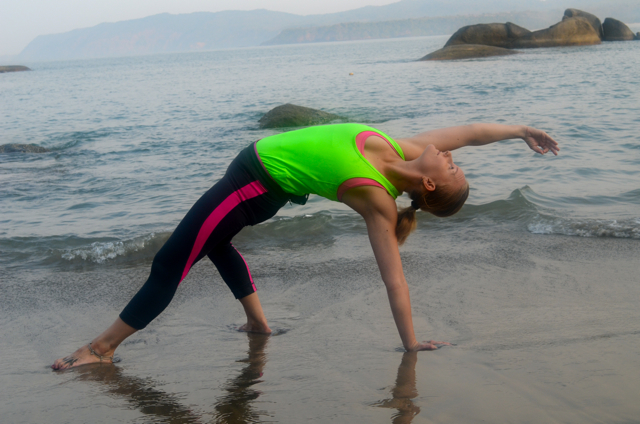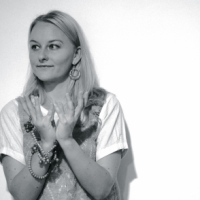The Ayurvedic theory of the five elements (Pancha Bhoota) that form our body, mind and the whole universe has been one of the most inspiring and meaningful pillars for my yoga practice so far.
Yoga and Ayurveda believe that we are made of Earth, Water, Fire, Air and Space/Sky (Ether), which reside in different parts of our body and govern different systems, affecting our minds, emotions and behaviour. Keeping them in balance helps us to stay healthy and happy.
Whenever they are out of control, it means we need to deal with different ailments. I love Ayurveda the most for the fact that it doesn’t label us, talking about imbalances of five elements instead.
It’s fascinating to observe the five elements in their daily games—their dialectics and influence on the body, mind and emotions. It’s inspiring to see how food and different lifestyles support or cause imbalances in each of them. It’s amusing to play with them, exploring our connections to them and understanding how they work in our bodies and minds.
I love focusing my yoga practice on these five elements, allowing myself to re-adjust the energy and reconnect to their qualities within myself.
Remembering that yoga doesn’t end on a yoga, mat here are some practices I love to cultivate:
1. Earth (Prithvi)
The earth element resides mainly in the structural parts of our body—in our bones and muscles. Associated with the primordial energy at the root of our spine (known in Yoga as Muladhara Chakra), earth is related to stability, solidity and security.
When the earth element is imbalanced, we might feel unstable, ungrounded and disconnected from reality, and we are quite easy to break down. We cannot focus or feel our life is “at the right place” or “like home.” We struggle on the basic level. We tend to be greedy or feel insecure.
When we have our earth element in balance, we feel good with ourselves, grounded and stable. We trust the universe and don’t worry too much about our basic survival. We feel strength and support.
Walking barefoot while pressing the feet firmly into the ground, sitting silently in nature or lying down in a Bridge pose works pretty well for me, but my favourite practice for earth element is pottery.
Touching the clay and playing with it, feeling the sticky matter underneath my palms gives a very special feeling of “being here and now” (writing this I cannot get rid of the famous scene with Demi Moore and Patrick Swayze from the movie Ghost).
Practical activities and being close to the “matter” help me feel my roots, my base, my foundations. The best part is you don’t need any professional equipment, especially if you have access to a garden or the beach. It’s nice to play around with soil, sand and water, or just being in your kitchen and doing things such as kneading dough.
2. Water (Jala)
As we all know, water is life. Babies are approximately 75 to 80 percent water. As we age, the percentage decreases a bit, but never goes below 60. Water is vital to every aspect of our bodies, especially the lymphatic and urinary systems, and controls both the flow of blood and the nourishment of our cells. All tissues need water to be healthy and perform their functions.
In yoga, water is related to Svadisthana Chakra and hip openers. Water represents creativity, fluidity, femininity, fertility, sensuality, sexuality and nourishment. When we feel stagnant or barren we might need to work on the water element. Water gives us freedom, as it flows constantly and allows us to “let go.”
My beloved practice for the water element is a gentle and smooth Vinyasa Flow. I like calling it “Zen Flow” as it is free flow controlled by the peace of mind. Usually I focus on one group of asanas to build the frame, then tune it with the breath (usually ujjayi).
Sometimes, I just love to come “blank” to my yoga mat and improvise as I keep my eyes closed and allow my body to express and flow freely. Sometimes a yoga sequence transforms into dance, and sometimes into prayer. I love to visualize the ocean and allow waves of my breath to come in and out—rhythmically, slowly, effortlessly.
3. Fire (Agni)
In yoga, fire is called Agni, and relates to our digestion and will power. It’s not only about a physical digestion, but also relates to our capacity to process our experiences, emotions and everything that happens to us. Fire is transformative, giving us the strength to take actions and make decisions. It is our core and centre.
Besides Agni Sara, the technique targeting our internal organs and based on contracting the abdomen to stimulate digestion and endocrine system, I love arm balances. They train our inner fire, our determination, commitment, strength and courage. They focus our attention and strengthen self-esteem. They support our metabolism and digestion by engaging the core muscles.
Twists are also a great choice, as they help organs get a nice squeeze to stimulate our inner fire and Manipura Chakra.
4. Air (Vayu)
Air in Ayurveda is actually called Vayu, which means “the wind” and is associated with Anahata Chakra, or the centre of the heart. The air element is responsible for movement as it travels in and out of our lungs, but also as it permeates our intestines and joints.
Whenever we move, it’s due to air. Air is dry, light and constantly in action; therefore, it is connected to our nervous system. Whenever our brains are engaged, millions of cells transmit impulses going through the body.
This connection of air and mind is amazingly expressed in Pranayama. Pranayama techniques vary in forms, but all of them target the nervous system through breath work. One of my favourite techniques is Anuloma Viloma, or alternate nostril breathing. We inhale through the right nostril (counting to four), and exhale through the left one (counting to eight), then opposite by inhaling through the left for four and exhaling right to eight.
There are many variations of this exercise, and each of them makes me feel lighter, brighter and happier!
5. Space /Sky/Ether (Aakash)
Space is limitless, having no boundaries, no weight and no gravity. It represents “openness,” higher functions of our brain, communication, spirituality, our “higher self,” consciousness, unity and “non-dual” transcendence. It’s the most abstract element, yet it’s absolutely needed for all the others to exist.
Meditation is the key for me, as it supports the feeling of connection to the world and of being “one” with the universe—the feeling of being free and experiencing our own unlimited potential.
Even when we struggle with sitting silently and witnessing our crazy minds, we still can try to connect to our inner observer and build this sacred distance between our thoughts and awareness of them. If you have trouble meditating, I recommend inversions. They work well in bringing a different perspective, and support higher functions of our brain and awareness, as well as our thyroid, pituitary and pineal glands.
The most important thing is to not judge or prefer any element over another. It is a proper balance among all of them that will bring health and joy to our lives.
~
Relephant Links:
Elemental Yoga: Balance Your 5 Elements. ~ Jai Garuda
~
Author: Karolina Krawczyk-Sharma
Apprentice Editor: Terry Price / Editor: Toby Israel
Image: Author’s Own
~












Read 0 comments and reply